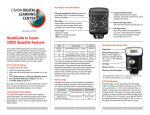Download Canon Speedlite 600EX-RT Owner`s manual
Transcript
Wireless Button QuickGuide to Speedlite 600EX-RT Optical Wireless Flash Setup INTRODUCTION The Speedlite 600EX-RT allows you to set up multiple Speedlites which can be wirelessly controlled and synchronized by a single master unit. This QuickGuide will describe how do this via the traditional Canon “optical” wireless flash method. Optical wireless flash control allows you to integrate the 600EX-RT with non-radio compatible Speedlite models, even some discontinued ones, for multiple flash set-ups with full E-TTL auto exposure. Your setup options include: •Automatic E-TTL with equal output from all firing groups •Automatic Ratio E-TTL with unequal (ratio) output between firing groups •Manually-set power output with a different flash output for each unit or firing group, if desired A “master” flash unit attached to the camera controls one or more off-camera “slave units.” It is also possible to have two or more cameras, each with a master unit attached, and to switch from one to another during a wireless flash shooting session. The slave lighting setup remains the same. The following Canon units have master capability with the optical wireless system: •Speedlites 600EX-RT, 580EX II, 580EX, 550EX, and newly-introduced 90EX • Speedlite Transmitter ST-E2 1 Fn Button 1 Flash Mode Button Fn Button 2 Flash Ready/Test Flash Fn Button 3 Fn Button 4 Select Dial SPEEDLITE 600EX-RT — INITIAL WIRELESS OPTICAL FLASH SETUP For this system to work you must first set the master and slaves to matching transmission channels. Once you have done so, any settings you make to the master are automatically transmitted to the slaves. This eliminates the need to adjust the slaves individually and manually. 1.Enable optical transmission on the master unit. Press the Wireless Flash Button until the <OPTICAL TRANSMISSION> (lightning bolt) icon, in upper-right corner of 600EX-RT LCD panel, and <MASTER> appear. The wireless flash button cycle normally is: Normal flash operation > Radio Master > Radio Slave > Optical Master > Optical Slave) 2. E nable optical transmission on 600EX-RT slave unit(s). Press the Wireless Flash Button until the <OPTICAL TRANSMISSION> icon and <SLAVE> appear. You can combine one or more 600EX-RTs as optical-based slave units with any combination of Speedlite 580EX II, 580EX, 550EX, 430EX II, 430EX, 420EX, 320EX, or 270EX II. Please refer to the owner’s manual for optical wireless flash setup instructions for these units. 3.Set the transmission channel. You must set the master and slave units to the same transmission channel, otherwise the slave(s) will not fire. Four channels are available. If other photographers are using Canon optical wireless setups nearby, using different transmission channels will prevent accidental triggering of each others’ flash units. 2 4. To set the Channel on a 600EX-RT master unit: a) Press Fn button 4 until <MENU 3> appears. b) Press Fn Button 1 (under the “CH” icon in Menu c)The channel number highlight will appear immediately below the upper-right lightning bolt icon. Turn Select Dial to a channel from 1 – 4, then press the Select/Set Button on the 600EX-RT to register your choice. 5. To set the Channel on Speedlite 600EX-RTs as slave unit(s): a) Press Fn Button 4 until <MENU 2> displays. b) Press Fn Button 1 (under the “CH” icon in Menu c)The channel number highlight will appear immediately below the <OPTICAL TRANSMISSION> icon. Turn selector dial to a channel from 1 – 4, then press the Select/Set Button to register your choice. MASTER FLASH FIRING ON/OFF You can choose whether master flash firing is ON and contributes to the flash exposure, or OFF and does not. When set to OFF, the master flash will still use flash pulses to control the slaves, however, these flash pulses will take place before the actual flash exposure, and will not appear in the finished picture. 1. Press Fn Button 4 until Menu 2 displays. 2.Press Fn Button 1 to set Master Flash Firing to ON or OFF. (Little beams of light appearing from the small flash icon indicate Master Flash is ON. When OFF, the three lines simulating emitted beams disappear.) WIRELESS E-TTL WITH ALL FLASHES FIRING AT EQUAL POWER In this mode all flash units will fire with automatic E-TTL exposure, to produce a standard flash exposure, which you can adjust with flash exposure compensation on your camera, as necessary. This mode is best for situations where you’re trying to evenly light a subject or area, such as by bouncing several flashes onto a ceiling to evenly light a large room. 1. Perform the initial flash setup described above. 2.Confirm that master and slave are set to the same channel. 3.Speedlite 600EX-RTs used as slave units in an evenpower set-up can be assigned to any group — A, B or C. (Groups D and E are not available in optical wireless mode.) 3 4.Position the camera and slave unit(s) within the correct operating range (10 meters/33 feet indoors), and so that the flash sensors on the front of the slave units (under the Canon logo) are pointed toward the master. 5.Press Fn 4 Button on the master unit until Menu 2 appears. Press Fn 2 Button (under “Ratio”, in Menu 2) repeatedly until ALL appears. Each press toggles you through <ALL>, <A:B> or <A:B C>. (You will also see Ratio Off in small letters on the Speedlite 600EX-RT’s LCD panel). 6.Press the <MODE> button on the master unit to set the master to E-TTL. This will automatically set the slave to E-TTL as well. 7.Press the Test Flash Button on the master flash to check operation. If a slave does not fire, make sure it is within the operating range and that its sensor is pointed toward the master. 8.Take the picture. The green flash exposure confirmation lamp on the master unit will light for 3 seconds to confirm standard flash exposure. OPTICAL WIRELESS E-TTL WITH RATIO CONTROL This mode enables you to divide the slave units into different firing groups (A:B or A:B C) and control the flash ratio (relative output) between them so that different groups have different output. Overall flash exposure will still be automatically controlled by your camera’s E-TTL system. You can also use flash exposure compensation (FEC) on your camera to adjust the overall exposure, as necessary. This mode ideal for set-ups where you want distinct shadows, or want to direct more light to some areas of a scene than others. 1. Perform the initial flash setup described above. 2.To set each slave unit’s firing group: With Menu 1 on the LCD panel of each slave unit, Press Fn Button 3 on each slave (under the “GR” icon). Set at least one unit to <A> and at least one other to <B>. 3. To set the ratio on the master unit: a. Press Fn Button 4 to display <Menu 2>. b.Press Fn Button 2 (under the RATIO icon). Each press toggles you through <ALL>, <A:B> or <A:B C>. Note: A:B requires a minimum of two units. A:B C requires a minimum of three. In either case, you can adjust the power ratio only between groups A and B. Group C is independent of A and B and is best used for lighting the background or for accent lighting, rather than lighting your main subject. 4 c. Press Fn Button 3, under the GR icon. d.Press Fn Button 3 again to display <A:B ±>, and highlight the ratio scale on the 600EX-RT’s LCD panel. e.Turn the Select Dial to set the flash ratio, then press the Select/Set button. f.Press Fn Button 4 to return to shoot-ready mode. All flash ratios are expressed as A relative to B and as relative amounts of exposure. For example, “1:1” means firing groups A and B will produce equal exposure, “2:1” means A will produce twice as much exposure as B, “1:4” means B will produce four times (2 stops) as much exposure as A, and “8:1” means A will produce eight times (3 stops) as much exposure as B. E-TTL General Notes 1.Flash coverage for optical wireless flash operation is set to 24mm by default. You can manually change the flash zoom coverage if you wish. 2.Press the depth-of-field preview button on the camera if you want to preview the lighting by firing a modeling flash. 3.If “Master Flash ON” is active, the master unit is always part of the “A” group — no exceptions. 4.During optical-based wireless E-TTL, a master unit will enter sleep mode (Auto Power Off) after about 90 seconds of inactivity. Activative Speedlite 600EX-RT Custom Function 01-1 if you wish to disable sleep mode on the master unit. 5.If a slave enters sleep mode, press the master unit’s test flash button to turn the slave back on. Slave units, by default, stay active for 60 minutes before going to sleep mode. You can use Flash C.Fn 10-1 to change this to 10 minutes to conserve slave unit battery power. 6.The following flash settings are available in E-TTL mode (all set on the master unit): • Flash exposure compensation • Flash exposure bracketing • Flash exposure lock • High-speed sync • Manual flash • Stroboscopic flash WIRELESS MANUAL FLASH In this mode you set each slave unit to a fixed output and set the camera exposure manually. You can set each unit to the same or a different output. This mode is ideal for lighting setups where the flash-to-subject distance is fixed and you want your exposure setting to be consistent from 5 one shot to the next—for example, when you are photographing subjects in the same scene whose color and reflectivity are variable. 1. Perform the initial flash setup described above. 2.Use the Mode Button on a 600EX-RT master unit to set the flash mode to <M>. 3. Set firing group ratio: While <MENU 1> is displayed on the master unit, press Fn Button 2 to the output ratio of your choice. Your options are: a. ALL (NO RATIO — EQUAL OUTPUT) b. A/B (RATIO A:B) c. A/B/C (RATIO A:B:C) All ratios are between firing groups. 4.Select a firing group: Press Fn Button 3 on the master unit, under the GR icon, then turn the Select Dial and select the group for which you want to set the flash output. Select A, B, or C. (It’s not possible to set a slave unit to groups D or E during optical wireless operation.) 5.Set the flash output: Press Fn Button 3 <* ±> again, and with the power level scale highlighted, turn the Select Dial to set the flash output, then press the Select/Set Button. 6.Repeat steps 3 and 4 on the master unit to select and set additional flash groups. 600EX-RT MEMORY FUNCTION You can save one set of wireless settings to memory and recall them later. This not only saves time during wireless setups, it’s also a quick way to switch from standard flash-on-camera to a commonly-used wireless set-up. The settings vary slightly depending on whether you are setting a master or slave. 1. To access the Memory menu: a.On the master unit: Press Fn Button 4 to display <MENU 3>. b.On the slave unit: Press Fn Button 4 to display <MENU 2>. 2. To save the settings to Memory: a. Press Fn Button 3 <MEMORY>. b. Press Fn Button 1 <SAVE>. 3. To apply the settings from Memory: a. Press Fn Button 2 <LOAD>. 6











